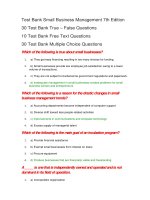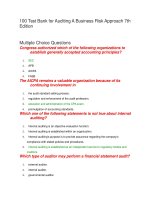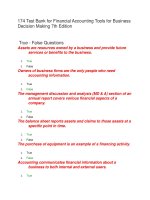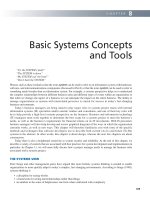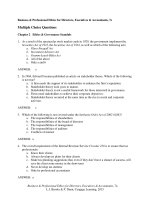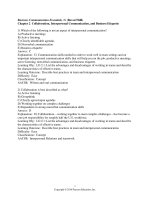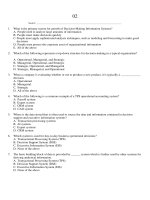Business driven technology 7th edition baltzan plug inb002
Bạn đang xem bản rút gọn của tài liệu. Xem và tải ngay bản đầy đủ của tài liệu tại đây (131.79 KB, 55 trang )
Plug-In B2
Business Process
True / False Questions
1. The process begins when a customer steps into line and ends when the customer
receives the receipt and leaves the store. The process steps are the activities the
customer and store personnel do to complete the transaction.
True
False
2. A business process is a standardized set of activities that accomplish a specific task,
such as processing a customer's order.
True
False
3. A business process can be viewed as a "value chain." By contributing to the creation
or delivery of a product or service, each step in a process should add value to the
preceding step.
AACSB: Reflective Thinking
AACSB: Technology
True
False
4. The continuous process improvement model attempts to understand and measure
the current process and make performance improvements accordingly.
True
False
5. Business process reengineering (BPR) is the analysis and redesign of workflow within
and between enterprises. BPR relies on a different school of thought than continuous
process improvement. In the extreme, BPR assumes the current process is irrelevant,
does not work, or is broken and must be overhauled from scratch.
True
False
6. Business process reengineering attempts to understand and measure the current
process and make performance improvements accordingly.
True
False
7. The continuous process improvement model is the analysis and redesign of workflow
within and between enterprises.
True
False
2-1
Copyright © 2018 McGraw-Hill Education. All rights reserved. No reproduction or distribution without the prior written consent of
McGraw-Hill Education.
8. Business process modeling (or mapping) is the activity of creating a detailed flow
chart or process map of a work process showing its inputs, tasks, and activities in a
structured sequence.
True
False
9. A business process model is a graphic description of a process, showing the sequence
of process tasks, which is developed for a specific purpose and from a selected
viewpoint.
True
False
10. The As-Is process model represents the current state of the operation that has been
mapped without any specific improvements or changes to existing processes.
True
False
11. The As-Is process model displays how the process problem will be solved or
implemented.
True
False
12. The To-Be process model represents the current state of the operation that has been
mapped without any specific improvements or changes to existing processes.
True
False
13. The To-Be process model displays how the process problem will be solved or
implemented. To-Be process models show the results of applying change
improvement opportunities to the current (As-Is) process model.
True
False
14. Business process management (BPM) integrates all of an organization's business
process to make individual processes more efficient.
True
False
15. Business process management tools are used to create an application that is helpful
in designing business process models and also helpful in simulating, optimizing,
monitoring, and maintaining various processes that occur within an organization.
True
False
16. Business process reengineering integrates all of an organization's business process to
make individual processes more efficient.
True
False
Multiple Choice Questions
2-2
Copyright © 2018 McGraw-Hill Education. All rights reserved. No reproduction or distribution without the prior written consent of
McGraw-Hill Education.
17. What is a business process?
A.
B.
C.
D.
A standardized set of activities that accomplish a specific task, such as processing
Rules and policies that result in a product or service that is received by an organiz
Rules and policies that are invisible to the external customer but essential to the
An attempt to understand and measure the current process and make performan
18. Which of the following is not one of the three key steps involved in business process
improvement?
A.
B.
C.
D.
Measure what matters to most customers.
Monitor the performance of key individuals.
Assign accountability for process improvement.
Monitor the performance of key business processes.
19. Which of the following is not one of the important characteristics of business
processes?
A.
B.
C.
D.
The processes have internal users.
The processes have external users.
The processes occur only within organizations.
The processes occur across organizations.
20. Which of the following is one of the important characteristics of business processes?
A.
B.
C.
D.
The process is cross-departmental.
The process has external users only.
The process occurs only within organizations.
The process has internal users only.
21. What is the continuous process improvement model?
A.
B.
C.
D.
A standardized set of activities that accomplish a specific task, such as processing
Rules and policies that result in a product or service that is received by an organiz
Rules and policies that are invisible to the external customer but essential to the
An attempt to understand and measure the current process and make performan
22. What is the analysis and redesign of workflow within and between enterprises?
A.
B.
C.
D.
Customer facing process
Business process reengineering
Continuous process improvement
Business process management
2-3
Copyright © 2018 McGraw-Hill Education. All rights reserved. No reproduction or distribution without the prior written consent of
McGraw-Hill Education.
23. What is a graphic description of a process, showing the sequence of process tasks,
that is developed for a specific purpose and from a selected viewpoint?
A.
B.
C.
D.
Business process model
As-Is process model
To-Be process model
Business process mapping (or modeling)
24. What represents the current state of the operation that has been mapped without
any specific improvements or changes to existing processes?
A.
B.
C.
D.
Business process model
As-Is process model
To-Be process model
Business process mapping (or modeling)
25. What shows the results of applying change improvement opportunities to the current
process model?
A.
B.
C.
D.
Business process model
As-Is process model
To-Be process model
Business process mapping (or modeling)
26. What is the activity of creating a detailed flow chart or process map of a work process
showing its inputs, tasks, and activities in a structured sequence?
A.
B.
C.
D.
Business process model
As-Is process model
To-Be process model
Business process mapping (or modeling)
27. What is used to create an application that is helpful in designing business process
models and also helpful in simulating, optimizing, monitoring, and maintaining
various processes that occur within an organization?
A.
B.
C.
D.
Business process model
Business process management tools
Business process management
Business process mapping (or modeling)
2-4
Copyright © 2018 McGraw-Hill Education. All rights reserved. No reproduction or distribution without the prior written consent of
McGraw-Hill Education.
28. What integrates all of an organization's business process to make individual
processes more efficient?
A.
B.
C.
D.
Business process model
Business process management tools
Business process management
Business process mapping (or modeling)
Essay Questions
29. Describe business processes and their importance to an organization.
30. Differentiate between customer facing processes and business facing processes.
31. Compare the continuous process improvement model and business process
reengineering.
2-5
Copyright © 2018 McGraw-Hill Education. All rights reserved. No reproduction or distribution without the prior written consent of
McGraw-Hill Education.
32. Describe business processes and their importance to an organization.
33. Explain business process management along with the reason for its importance to an
organization.
2-6
Copyright © 2018 McGraw-Hill Education. All rights reserved. No reproduction or distribution without the prior written consent of
McGraw-Hill Education.
Plug-In B2 Business Process Answer Key
True / False Questions
1.
The process begins when a customer steps into line and ends when the customer
receives the receipt and leaves the store. The process steps are the activities the
customer and store personnel do to complete the transaction.
TRUE
Accessibility: Keyboard Navigation
Blooms: Remember
Difficulty: 1 Easy
Learning Objective: B2-01 Describe business processes and their importance to an organization.
Topic: Business Process
2.
A business process is a standardized set of activities that accomplish a specific
task, such as processing a customer's order.
TRUE
Accessibility: Keyboard Navigation
Blooms: Remember
Difficulty: 1 Easy
Learning Objective: B2-01 Describe business processes and their importance to an organization.
Topic: Business Process
3.
A business process can be viewed as a "value chain." By contributing to the
creation or delivery of a product or service, each step in a process should add
value to the preceding step.
AACSB: Reflective Thinking
AACSB: Technology
TRUE
Accessibility: Keyboard Navigation
Blooms: Remember
Difficulty: 1 Easy
Learning Objective: B2-01 Describe business processes and their importance to an organization.
Topic: Business Process
4.
The continuous process improvement model attempts to understand and measure
the current process and make performance improvements accordingly.
TRUE
Accessibility: Keyboard Navigation
Blooms: Remember
Difficulty: 1 Easy
Learning Objective: B2-02 Compare the continuous process improvement model and business process
reengineering.
Topic: Business Process Improvement
2-7
Copyright © 2018 McGraw-Hill Education. All rights reserved. No reproduction or distribution without the prior written consent of
McGraw-Hill Education.
5.
Business process reengineering (BPR) is the analysis and redesign of workflow
within and between enterprises. BPR relies on a different school of thought than
continuous process improvement. In the extreme, BPR assumes the current
process is irrelevant, does not work, or is broken and must be overhauled from
scratch.
TRUE
Accessibility: Keyboard Navigation
Blooms: Remember
Difficulty: 1 Easy
Learning Objective: B2-02 Compare the continuous process improvement model and business process
reengineering.
Topic: Business Process Improvement
6.
Business process reengineering attempts to understand and measure the current
process and make performance improvements accordingly.
FALSE
The continuous process improvement model attempts to understand and measure
the current process and make performance improvements accordingly.
Accessibility: Keyboard Navigation
Blooms: Remember
Difficulty: 1 Easy
Learning Objective: B2-02 Compare the continuous process improvement model and business process
reengineering.
Topic: Business Process Improvement
7.
The continuous process improvement model is the analysis and redesign of
workflow within and between enterprises.
FALSE
Business process reengineering (BPR) is the analysis and redesign of workflow
within and between enterprises. BPR relies on a different school of thought than
continuous process improvement. In the extreme, BPR assumes the current
process is irrelevant, does not work, or is broken and must be overhauled from
scratch.
Accessibility: Keyboard Navigation
Blooms: Remember
Difficulty: 1 Easy
Learning Objective: B2-02 Compare the continuous process improvement model and business process
reengineering.
Topic: Business Process Improvement
8.
Business process modeling (or mapping) is the activity of creating a detailed flow
chart or process map of a work process showing its inputs, tasks, and activities in
a structured sequence.
TRUE
Accessibility: Keyboard Navigation
Blooms: Remember
Difficulty: 1 Easy
Learning Objective: B2-03 Describe the importance of business process modeling (or mapping) and business
process models.
Topic: Business Process Design
2-8
Copyright © 2018 McGraw-Hill Education. All rights reserved. No reproduction or distribution without the prior written consent of
McGraw-Hill Education.
9.
A business process model is a graphic description of a process, showing the
sequence of process tasks, which is developed for a specific purpose and from a
selected viewpoint.
TRUE
Accessibility: Keyboard Navigation
Blooms: Remember
Difficulty: 1 Easy
Learning Objective: B2-03 Describe the importance of business process modeling (or mapping) and business
process models.
Topic: Business Process Design
10.
The As-Is process model represents the current state of the operation that has
been mapped without any specific improvements or changes to existing
processes.
TRUE
Accessibility: Keyboard Navigation
Blooms: Remember
Difficulty: 1 Easy
Learning Objective: B2-03 Describe the importance of business process modeling (or mapping) and business
process models.
Topic: Business Process Design
11.
The As-Is process model displays how the process problem will be solved or
implemented.
FALSE
The To-Be process model displays how the process problem will be solved or
implemented.
Accessibility: Keyboard Navigation
Blooms: Remember
Difficulty: 1 Easy
Learning Objective: B2-03 Describe the importance of business process modeling (or mapping) and business
process models.
Topic: Business Process Design
12.
The To-Be process model represents the current state of the operation that has
been mapped without any specific improvements or changes to existing
processes.
FALSE
The As-Is process model represents the current state of the operation that has
been mapped without any specific improvements or changes to existing processes.
Accessibility: Keyboard Navigation
Blooms: Remember
Difficulty: 1 Easy
Learning Objective: B2-03 Describe the importance of business process modeling (or mapping) and business
process models.
Topic: Business Process Design
2-9
Copyright © 2018 McGraw-Hill Education. All rights reserved. No reproduction or distribution without the prior written consent of
McGraw-Hill Education.
13.
The To-Be process model displays how the process problem will be solved or
implemented. To-Be process models show the results of applying change
improvement opportunities to the current (As-Is) process model.
TRUE
Accessibility: Keyboard Navigation
Blooms: Remember
Difficulty: 1 Easy
Learning Objective: B2-03 Describe the importance of business process modeling (or mapping) and business
process models.
Topic: Business Process Design
14.
Business process management (BPM) integrates all of an organization's business
process to make individual processes more efficient.
TRUE
Accessibility: Keyboard Navigation
Blooms: Remember
Difficulty: 1 Easy
Learning Objective: B2-04 Explain business process management along with the reason for its importance to
an organization.
Topic: Business Process Modeling
15.
Business process management tools are used to create an application that is
helpful in designing business process models and also helpful in simulating,
optimizing, monitoring, and maintaining various processes that occur within an
organization.
TRUE
Accessibility: Keyboard Navigation
Blooms: Remember
Difficulty: 1 Easy
Learning Objective: B2-04 Explain business process management along with the reason for its importance to
an organization.
Topic: Business Process Modeling
16.
Business process reengineering integrates all of an organization's business process
to make individual processes more efficient.
FALSE
Accessibility: Keyboard Navigation
Blooms: Remember
Difficulty: 1 Easy
Learning Objective: B2-04 Explain business process management along with the reason for its importance to
an organization.
Topic: Business Process Modeling
Multiple Choice Questions
2-10
Copyright © 2018 McGraw-Hill Education. All rights reserved. No reproduction or distribution without the prior written consent of
McGraw-Hill Education.
17.
What is a business process?
A
.st
an
da
rdi
ze
d
se
t
of
ac
tiv
iti
es
th
at
ac
co
m
pli
sh
a
sp
eci
fic
ta
sk,
su
ch
as
pr
oc
es
sin
g
a
cu
st
o
m
er'
s
or
de
r
2-11
Copyright © 2018 McGraw-Hill Education. All rights reserved. No reproduction or distribution without the prior written consent of
McGraw-Hill Education.
B
Ru
.les
an
d
po
lici
es
th
at
re
sul
t
in
a
pr
od
uc
t
or
se
rvi
ce
th
at
is
re
cei
ve
d
by
an
or
ga
niz
ati
on
's
ex
ter
na
l
cu
st
o
m
er
2-12
Copyright © 2018 McGraw-Hill Education. All rights reserved. No reproduction or distribution without the prior written consent of
McGraw-Hill Education.
C
Ru
.les
an
d
po
lici
es
th
at
ar
e
in
vis
ibl
e
to
th
e
ex
ter
na
l
cu
st
o
m
er
bu
t
es
se
nti
al
to
th
e
eff
ec
tiv
e
m
an
ag
e
m
en
t
of
th
e
bu
sin
es
s
an
2-13
Copyright © 2018 McGraw-Hill Education. All rights reserved. No reproduction or distribution without the prior written consent of
McGraw-Hill Education.
d
inc
lu
de
go
al
se
tti
ng
,
da
ytoda
y
pl
an
ni
ng
,
pe
rfo
rm
an
ce
fe
ed
ba
ck,
re
wa
rd
s,
an
d
re
so
ur
ce
all
oc
ati
on
2-14
Copyright © 2018 McGraw-Hill Education. All rights reserved. No reproduction or distribution without the prior written consent of
McGraw-Hill Education.
D
An
.att
e
m
pt
to
un
de
rst
an
d
an
d
m
ea
su
re
th
e
cu
rre
nt
pr
oc
es
s
an
d
m
ak
e
pe
rfo
rm
an
ce
im
pr
ov
e
m
en
ts
ac
co
rdi
ng
ly
This is the definition of business process.
Accessibility: Keyboard Navigation
Blooms: Remember
Difficulty: 1 Easy
Learning Objective: B2-01 Describe business processes and their importance to an organization.
Topic: Business Process
2-15
Copyright © 2018 McGraw-Hill Education. All rights reserved. No reproduction or distribution without the prior written consent of
McGraw-Hill Education.
2-16
Copyright © 2018 McGraw-Hill Education. All rights reserved. No reproduction or distribution without the prior written consent of
McGraw-Hill Education.
2-17
Copyright © 2018 McGraw-Hill Education. All rights reserved. No reproduction or distribution without the prior written consent of
McGraw-Hill Education.
18.
Which of the following is not one of the three key steps involved in business
process improvement?
A
M
.ea
su
re
w
ha
t
m
att
er
s
to
m
os
t
cu
st
o
m
er
s.
B
M
.on
ito
r
th
e
pe
rfo
rm
an
ce
of
ke
y
in
di
vi
du
als
.
2-18
Copyright © 2018 McGraw-Hill Education. All rights reserved. No reproduction or distribution without the prior written consent of
McGraw-Hill Education.
C
As
.sig
n
ac
co
un
ta
bil
ity
for
pr
oc
es
s
im
pr
ov
e
m
en
t.
D
M
.on
ito
r
th
e
pe
rfo
rm
an
ce
of
ke
y
bu
sin
es
s
pr
oc
es
se
s.
Monitor the performance of key individuals is not one of the three key steps
involved in business process improvement.
Accessibility: Keyboard Navigation
Blooms: Remember
Difficulty: 1 Easy
Learning Objective: B2-01 Describe business processes and their importance to an organization.
Topic: Business Process
2-19
Copyright © 2018 McGraw-Hill Education. All rights reserved. No reproduction or distribution without the prior written consent of
McGraw-Hill Education.
2-20
Copyright © 2018 McGraw-Hill Education. All rights reserved. No reproduction or distribution without the prior written consent of
McGraw-Hill Education.
19.
Which of the following is not one of the important characteristics of business
processes?
A
Th
.e
pr
oc
es
se
s
ha
ve
int
er
na
l
us
er
s.
B
Th
.e
pr
oc
es
se
s
ha
ve
ex
ter
na
l
us
er
s.
2-21
Copyright © 2018 McGraw-Hill Education. All rights reserved. No reproduction or distribution without the prior written consent of
McGraw-Hill Education.
C
Th
.e
pr
oc
es
se
s
oc
cu
r
on
ly
wi
thi
n
or
ga
ni
za
tio
ns
.
D
Th
.e
pr
oc
es
se
s
oc
cu
r
ac
ro
ss
or
ga
ni
za
tio
ns
.
Business processes occur across organizations, not only within organizations.
Accessibility: Keyboard Navigation
Blooms: Remember
Difficulty: 2 Medium
Learning Objective: B2-01 Describe business processes and their importance to an organization.
Topic: Business Process
2-22
Copyright © 2018 McGraw-Hill Education. All rights reserved. No reproduction or distribution without the prior written consent of
McGraw-Hill Education.
2-23
Copyright © 2018 McGraw-Hill Education. All rights reserved. No reproduction or distribution without the prior written consent of
McGraw-Hill Education.
20.
Which of the following is one of the important characteristics of business
processes?
A
Th
.e
pr
oc
es
s
is
cr
os
sde
pa
rt
m
en
tal
.
B
Th
.e
pr
oc
es
s
ha
s
ex
ter
na
l
us
er
s
on
ly.
2-24
Copyright © 2018 McGraw-Hill Education. All rights reserved. No reproduction or distribution without the prior written consent of
McGraw-Hill Education.
C
Th
.e
pr
oc
es
s
oc
cu
rs
on
ly
wi
thi
n
or
ga
ni
za
tio
ns
.
D
Th
.e
pr
oc
es
s
ha
s
int
er
na
l
us
er
s
on
ly.
Processes are cross-departmental.
Accessibility: Keyboard Navigation
Blooms: Remember
Difficulty: 1 Easy
Learning Objective: B2-01 Describe business processes and their importance to an organization.
Topic: Business Process
2-25
Copyright © 2018 McGraw-Hill Education. All rights reserved. No reproduction or distribution without the prior written consent of
McGraw-Hill Education.
